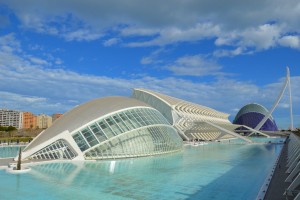Study in Valencia, Spain
Study in Valencia, Spain

If you’re planning to visit, or even settle permanently in the beautiful city of Valencia, Spain, some of the first things you will notice about this Mediterranean jewel are the incredible rays of light that seemingly reach every corner of the city, the tremendous and very temperate year-round weather and the friendly, outgoing nature of its people. All of these characteristics are immediately apparent in this wonderful metropolis, which, together with Barcelona, is one of the most important and fastest-growing cities on the Spanish Mediterranean coast.
A city of great cultural diversity, Valencia is the capital of the autonomous community of the same name and the third largest city in Spain after Madrid and Barcelona, hosting roughly 800,000 permanent residents in the city proper. Valencia’s urban area, which extends beyond the administrative city limits, is even larger, boasting a population of approximately 1.5 million people. Moreover, Valencia is Spain's third largest metropolitan area, with a population ranging somewhere between 1.7 and 2.5 million. The city has earned global city status, and its Port of Valencia is the 5th busiest container port in Europe and the busiest port on the Mediterranean Sea.
Valencia, which was founded as a Roman colony in 138 BC, is situated on the banks of the Turia, on the east coast of the Iberian Peninsula, fronting the Gulf of Valencia on the Mediterranean Sea. Its historic center is one of the largest in Spain, with approximately 169 hectares of space. It is here where you can witness firsthand the heritage of the city’s ancient monuments, as well as the other cultural attractions that make Valencia one of the country's most popular tourist destinations.
Fortunately (and by design), there is still plenty of old Valencia to be found in what is now a bustling city. Everywhere you look you are guaranteed to see many examples in which the modernity of the 21st Century has been blended harmoniously with the city’s historical past, combining technological developments with old-world simplicity.
Valencia is a city with no shortage of things to do and see. Many of the older sites can be found on the ancient winding streets of the Barrio del Carmen, which contains buildings dating back to Roman and Arabic times. One of the prime tourist attractions is known simply as “the Cathedral,” a majestic structure built between the 13th and 15th centuries. It is largely constructed in the Gothic style of architecture, but it also contains subtle elements of the Baroque and Romanesque styles.
Some of the other ancient and prominent sites to visit in Valencia include the Basilica of the Virgin (Basílica De La Virgen De Los Desamparados); the 15th-century Serrano and Quart towers, both of which are part of what was once a strategic wall surrounding the city; and the Silk Exchange market (La Llotja de la Seda), designed and built in the early Valencian Gothic style. The market was recently recognized by the cultural arm of the United Nations, known as UNESCO, as a World Heritage Site.
Valencia is home to a number of medieval churches, such as the ancient church of the Knights Templar and the Church of San Nicolás. The largest plaza in Valencia is the Plaza del Ayuntamiento; which hosts the City Hall (Ayuntamiento) on its western side and the central post office (Edificio de Correos) on its eastern side, a cinema that shows classic movies, and many restaurants and bars. The plaza is triangular in shape, with a large cement lot at the southern end, normally surrounded by flower vendors. The plaza serves as ground zero during the Les Falles festivities—Valencia’s most important celebration—when the fireworks of the Mascletà can be heard every afternoon.
Museums also abound in Valencia and include the Museu de Prehistòria de València (Prehistory Museum of Valencia); the Museu de Belles Arts San Pío V (Museum of Fine Arts); and the Museu d'Història de València (Valencia History Museum).
Of course, like any large city Valencia offers plenty of other diversions to pursue, including an unlimited number of shops, restaurants, bars and nightclubs. A unique and very enjoyable gathering spot for locals and tourists alike is the city’s futuristic “City of Arts and Sciences,” designed by world-renowned (and Valencia native) architect Santiago Calatrava. At this Valencian hotspot you’ll find an opera house/performing arts center, a science museum, an IMAX cinema/planetarium, an ocean-themed park and other structures such as a long covered walkway lined with tasty restaurants and trendy bars. Calatrava is also responsible for the bridge named after him in the center of the city.
Finally, if you’re looking to relax and unwind after a busy day of sightseeing, Valencia offers plenty of parks, gardens and other green spaces. Some of the more popular of these are the Jardines de Monforte (Montforte Gardens), the Jardin Botanico (Botanical Gardens), and the Jardines del Real or Jardines de Viveros (Real Gardens), located in the Pla del Real district, on the former site of the Real Palace.

